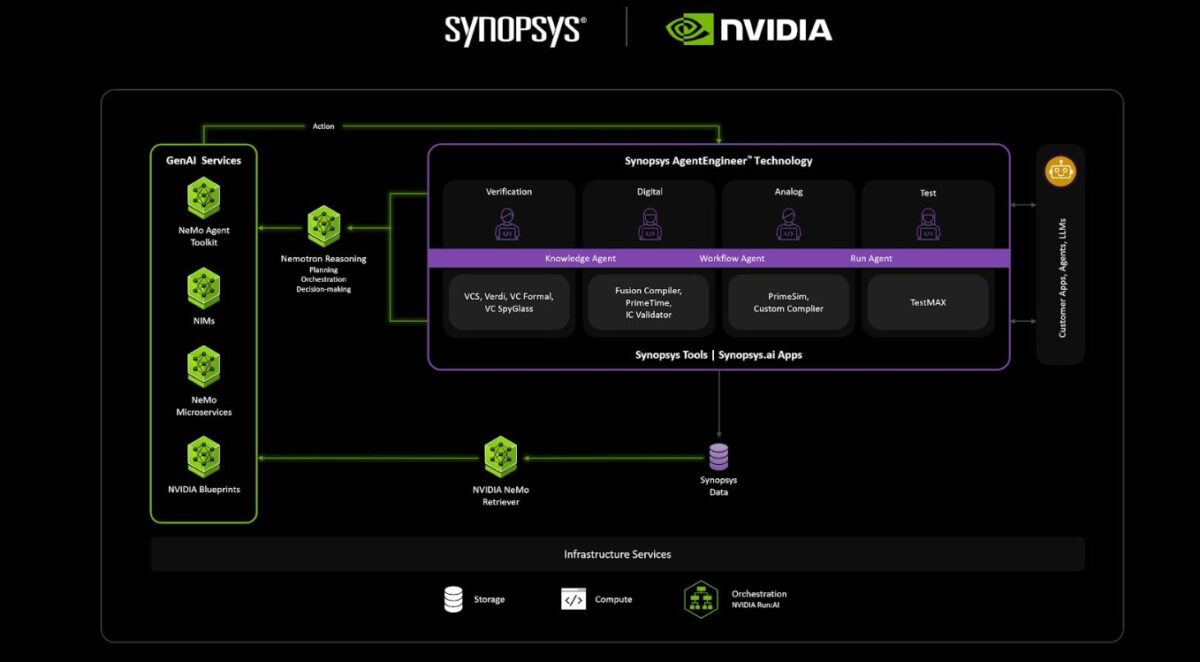Key Takeaways
- Synopsys and NVIDIA are deepening their partnership to innovate semiconductor design using agentic AI, GPU-accelerated computing, and AI-driven physics simulations.
- The integration of Synopsys’ AgentEngineer™ technology with NVIDIA’s NeMo Agent Toolkit aims to transform AI from a tool into a collaborative partner for autonomous design flows.
- Synopsys’ software suite, enhanced by NVIDIA’s GPU capabilities, is set to achieve significant performance improvements, such as 500x speedup in fluid simulations and 15x gains in atomistic simulations.

In a landmark announcement at NVIDIA’s GTC Washington, D.C.…
Key Takeaways
- Synopsys and NVIDIA are deepening their partnership to innovate semiconductor design using agentic AI, GPU-accelerated computing, and AI-driven physics simulations.
- The integration of Synopsys’ AgentEngineer™ technology with NVIDIA’s NeMo Agent Toolkit aims to transform AI from a tool into a collaborative partner for autonomous design flows.
- Synopsys’ software suite, enhanced by NVIDIA’s GPU capabilities, is set to achieve significant performance improvements, such as 500x speedup in fluid simulations and 15x gains in atomistic simulations.

In a landmark announcement at NVIDIA’s GTC Washington, D.C. conference Synopsys unveiled deepened collaborations with NVIDIA to revolutionize semiconductor design and engineering through agentic AI, GPU-accelerated computing, and AI-driven physics simulations. This partnership, building on over three decades of joint innovation, integrates Synopsys’ expansive portfolio (now bolstered by its recent acquisition of Ansys) with NVIDIA’s cutting-edge AI and GPU technologies.
The goal: empower engineers to tackle unprecedented challenges in chip design, manufacturing, and system-level simulations with unprecedented speed, accuracy, and intuition.
At the heart of the announcement is agentic AI for next-generation semiconductor development. Synopsys is fusing its AgentEngineer™ technology with NVIDIA’s NeMo Agent Toolkit, incorporating Nemotron open models and datasets. This synergy supercharges autonomous design flows, transforming AI from a mere tool into a collaborative partner that optimizes workflows, enhances productivity, and accelerates time-to-market. For instance, Synopsys’ chip design agents, currently in development, streamline formal verification processes. These agents deepen signoff efficiency, uncover critical bugs overlooked by human reviewers, and boost overall design quality. NVIDIA is piloting this AgentEngineer tech for AI-enabled formal verification, underscoring its practical impact on advanced node processes like 2nm and beyond. By automating repetitive tasks and providing intelligent insights, agentic AI addresses the escalating complexity of AI chips, where design cycles have ballooned amid exploding transistor counts and power constraints.
Complementing this is accelerated computing, leveraging NVIDIA’s GPU prowess to turbocharge Synopsys’ software suite, the industry’s broadest, spanning nearly 20 GPU-optimized products. Synopsys is expanding integrations for compute-intensive workloads, including EDA, test, and manufacturing tools. A standout example is Ansys Fluent® computational fluid dynamics (CFD) software, which achieves a staggering 500x speedup via GPU acceleration and AI initialization for fluid simulations, vital for thermal management in high-performance AI data centers. Similarly, Synopsys QuantumATK® for atomistic simulations delivers up to 15x performance gains using NVIDIA libraries and GPUs, rendered seamlessly in NVIDIA Omniverse for immersive visualization. These enhancements extend to computational lithography, where Synopsys’ OPC software on NVIDIA’s cuLitho platform slashes runtime compared to CPU-based methods, enabling TSMC and others to push physics limits for sub-2nm nodes. The result? Faster iterations, reduced energy consumption, and scalable simulations for everything from quantum devices to hyperscale systems.
The third pillar, AI physics, merges NVIDIA’s AI physics engines with Synopsys’ simulation tools to model real-world complexities with extraordinary fidelity. Engineers can now simulate atomic-scale semiconductor behaviors or macro-scale phenomena like aircraft aerodynamics in Omniverse, blending physics-based accuracy with AI’s predictive power. “With NVIDIA AI physics technologies and agentic AI integrated within Synopsys tools, engineers are empowered to simulate the complexities of the real world with extraordinary fidelity and speed,” stated Synopsys executives. This is particularly transformative for automotive and aerospace, where Synopsys’ digital twin solutions—integrated with Omniverse—validate software-defined vehicles pre-manufacturing, slashing costs and enhancing safety.
These collaborations arrive at a pivotal moment. The semiconductor industry faces mounting pressures: AI demand surges transistor densities, geopolitical tensions strain supply chains, and sustainability mandates demand efficient designs. Synopsys’ post-Ansys portfolio spans silicon-to-systems, from EDA to multiphysics, positioning it to unlock insights across scales. NVIDIA’s Blackwell GPUs and CUDA-X libraries further amplify this, with Synopsys adopting them for TCAD and lithography to yield “unprecedented performance gains,” per Sanjay Bali, Synopsys’ SVP of strategy.
The implications ripple outward. For chipmakers like TSMC and Intel, agentic AI means fewer design respins and quicker innovation ramps. In automotive, Omniverse-enabled twins could halve validation times for Level 4 autonomy. Broader industries, from energy to healthcare, benefit as AI physics democratizes high-fidelity modeling. Yet challenges remain: ensuring AI agents’ trustworthiness in safety-critical apps and scaling GPU infrastructure amid chip shortages.
Bottom line: This NVIDIA-Synopsys alliance heralds an era where engineering is intuitive and boundary-pushing. By weaving agentic AI’s autonomy, accelerated computing’s velocity, and AI physics’ precision, it promises to fuel the next industrial revolution—one where silicon dreams become reality faster than ever.
Also Read:
Chiplets: Powering the Next Generation of AI Systems
The Rise, Fall, and Rebirth of In-Circuit Emulation: Real-World Case Studies (Part 2 of 2)
Statically Verifying RTL Connectivity with Synopsys
Share this post via: